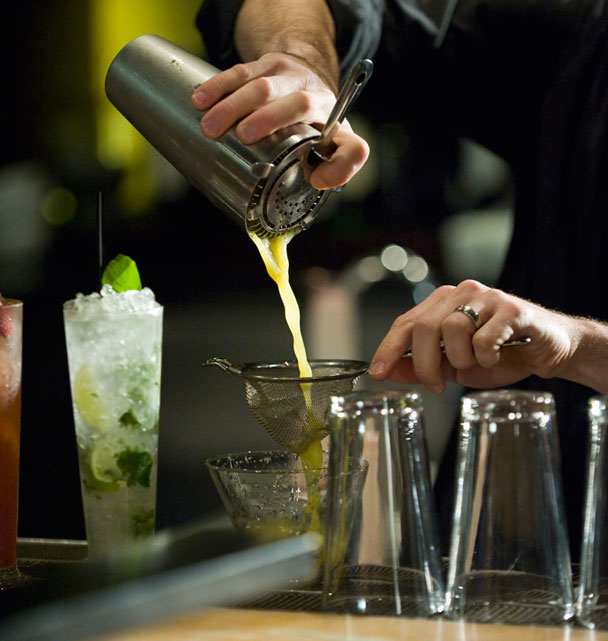As grand institutions go, the New York Public Library is not the most staid. But the quiet pleasure of reading has about as much to do with the event there on a recent May night as a medical detox has with absinthe. It was the gala opening of the second annual Manhattan Cocktail Classic, and 3,333 revelers (the official figure from the event organizers) in after–five frocks and fascinators, or well–cut suits—or, occasionally, kilts, or ball gowns—thronged the marble halls and wood–paneled chambers, flitting among 115 exhibitors’ stands, each one manned by a mixologist or six, shaking, stirring, muddling, floating, jiggering, and julepping. Freeze technicians with liquid–nitrogen backpacks and aviator helmets circulated. Go–go dancers in kinky boots and silver bikinis gyrated on plinths in the Celeste Bartos Forum. French trapeze artists flew in the basement. Forty thousand cocktails were imbibed (official figure), of which I was personally responsible for a dozen. Oh stop. I was tasting. Starting with Tony Abou–Ganim’s classic Negroni at the Campari stand, then Kansas’ Earth Friendly Distilling Company’s vodka distilled (not infused) with two kinds of chocolate, then…my notes seem to have run out.
It was your standard cocktail festival scene. The fact that there are enough cocktail festivals to create a standard is pretty surprising, but there are. They’re popping up all over. The big daddy, with around 19,000 attendees, is the bacchanalian Tales of the Cocktail in New Orleans (July 20–24, 2011, will be the ninth), in which 207 gallons of bitters, 162 gallons of lime juice, and 960 Luxardo cherries were consumed last year. (Spirits professionals are fond of a statistic, often involving citrus.) It’s now spawning offshoots, starting with Tales of the Cocktail on Tour Vancouver last March. There are “Cocktail Weeks”—including one in midtown Sacramento in August, San Francisco in September, and Portland in October—and there are international extravaganzas, including, over the rest of 2011, the Sydney Bar Show Week (September 11–14), the Bar Convent Berlin (October 10–11), the second London Cocktail Week (October 10–16), and, in February 2012, the second Copenhagen Spirits and Cocktails Festival. The question is: Why is this catching on, and why now?
“It’s because we live in horrible times,” says Dave Wondrich, a major presence on the mixology circuit, Esquire’s drinks correspondent, an authority on the history of the American cocktail, author of three cocktail books, founding advisor to the Manhattan Classic, punch enthusiast, speaker, educator and (duh) bon viveur. “It’s anxiety over our automated world; part of the fetishization of the cocktail and revival of the bartender craft—a subset of the food world. This is all stuff that’s very hands–on. You can go to a bar, sit down, and watch a bartender make something for you and you alone. You don’t get that much any more.”
Fetishization is the word. In salons, clubs, and lounges across the land—the world!—youngsters with waxed moustaches and interesting beards, steampunk tin–buttoned vests, fox–fur shrugs and ’40s tea dresses with armfuls of tattoos are brewing 12 kinds of bitters, infusing spirits with herbs, and double–freezing ice into precise 1–inch cubes. It’s as far from Tom Cruise juggling with neon shakers as you can get.
And it’s fitting that New Orleans hosts the seminal cocktail event—the Big Easy is stylistically and historically appropriate, and after Katrina, poignantly, even more so: They needed visitors, and everyone needed a handcrafted beverage. Founder Ann Tuennerman saw the explosion of the cocktail coming, even back in 2002 when the inaugural Tales was a little afternoon event. “In all honesty nothing [surprises me],” she says. “From the get–go we knew there would be a tremendous return on our effort and that the harder we worked the larger the event would grow and the more we would be able to give back and support the industry.” Tuennerman gives back to the city at the same time as the industry: with mixology scholarship programs offered by the New Orleans Culinary and Cultural Preservation Society she founded in 2006. In fact, this whole circuit has a lot of supporting–the–industry and encouraging–the–little–guys going on. “The circuit is competitive,” says Wondrich. “But it’s friendly competition. Here everybody has to be friendly. You have to be a sport.” It’s as if the warm glow of a well–made Brandy Crusta (Wondrich’s tipple of choice) were infusing the entire community.



 Pinterest
Pinterest


